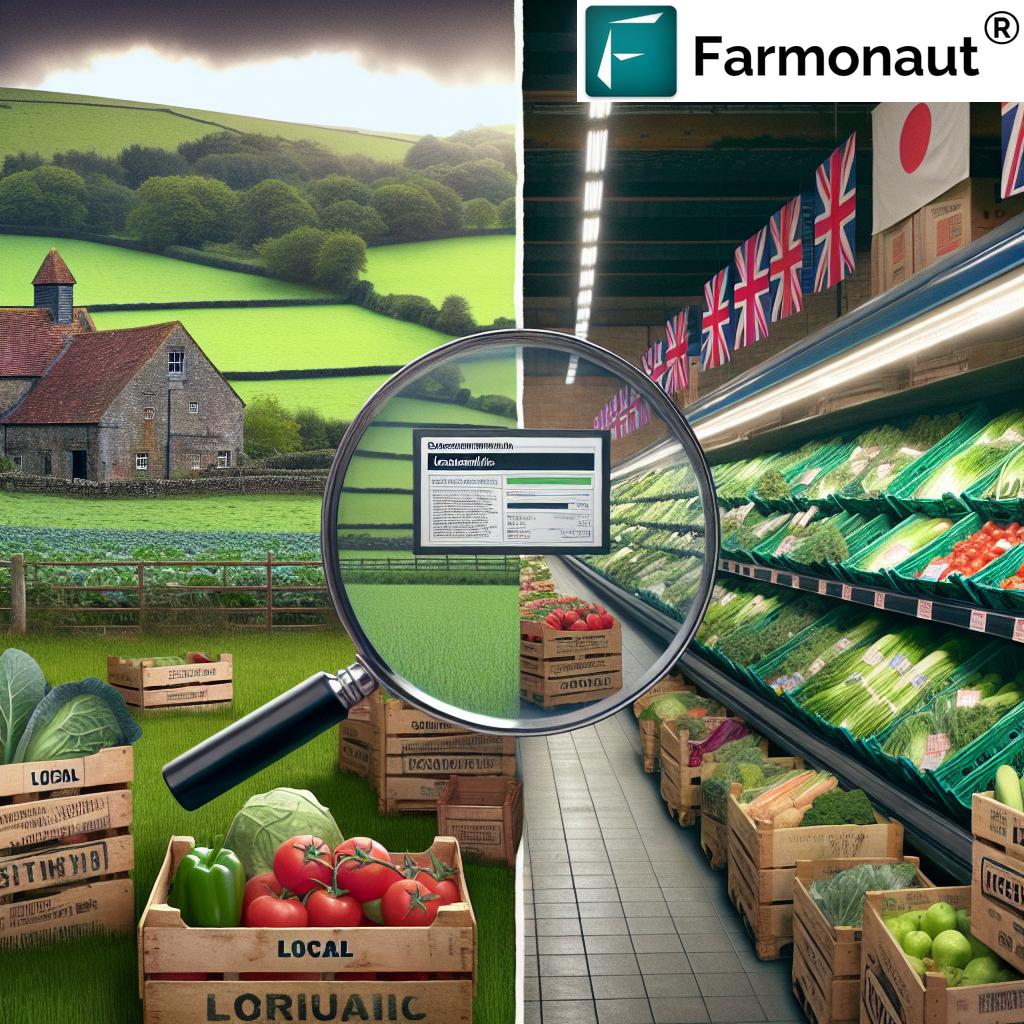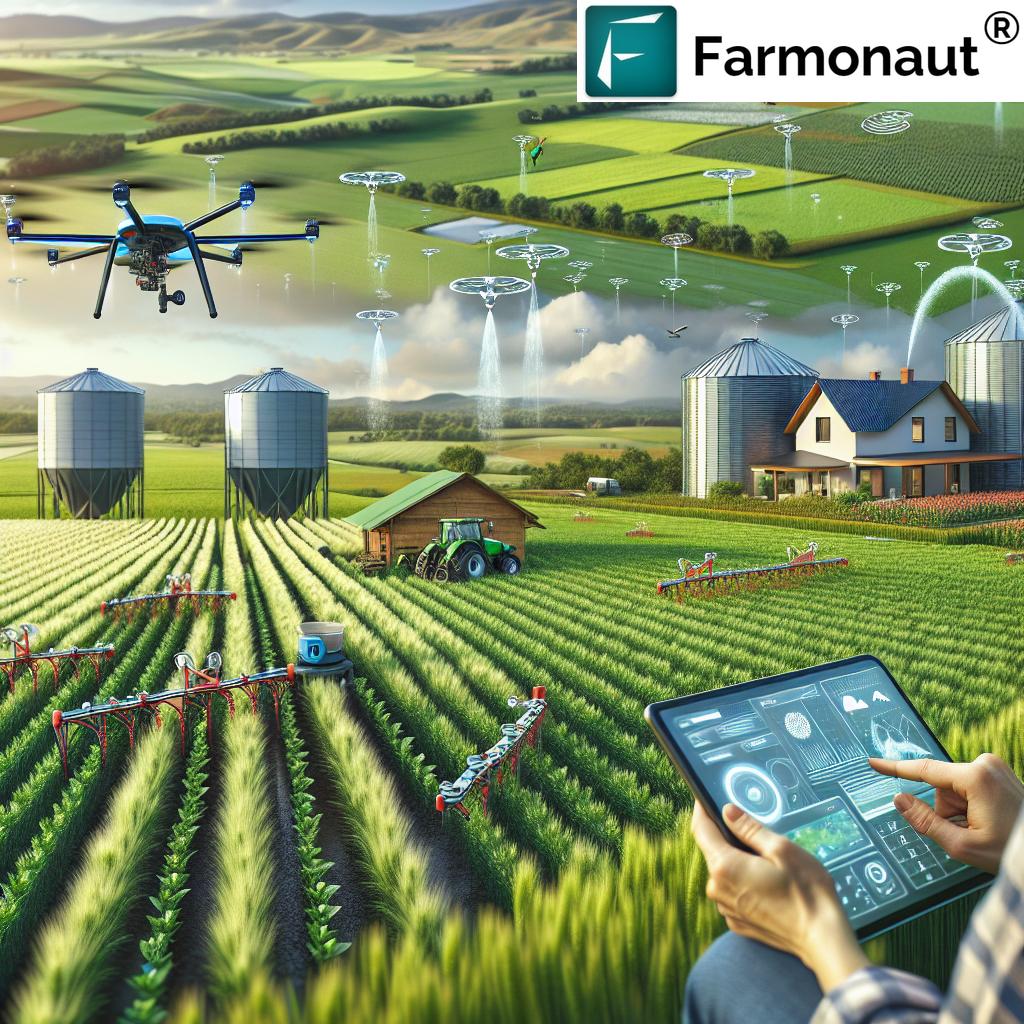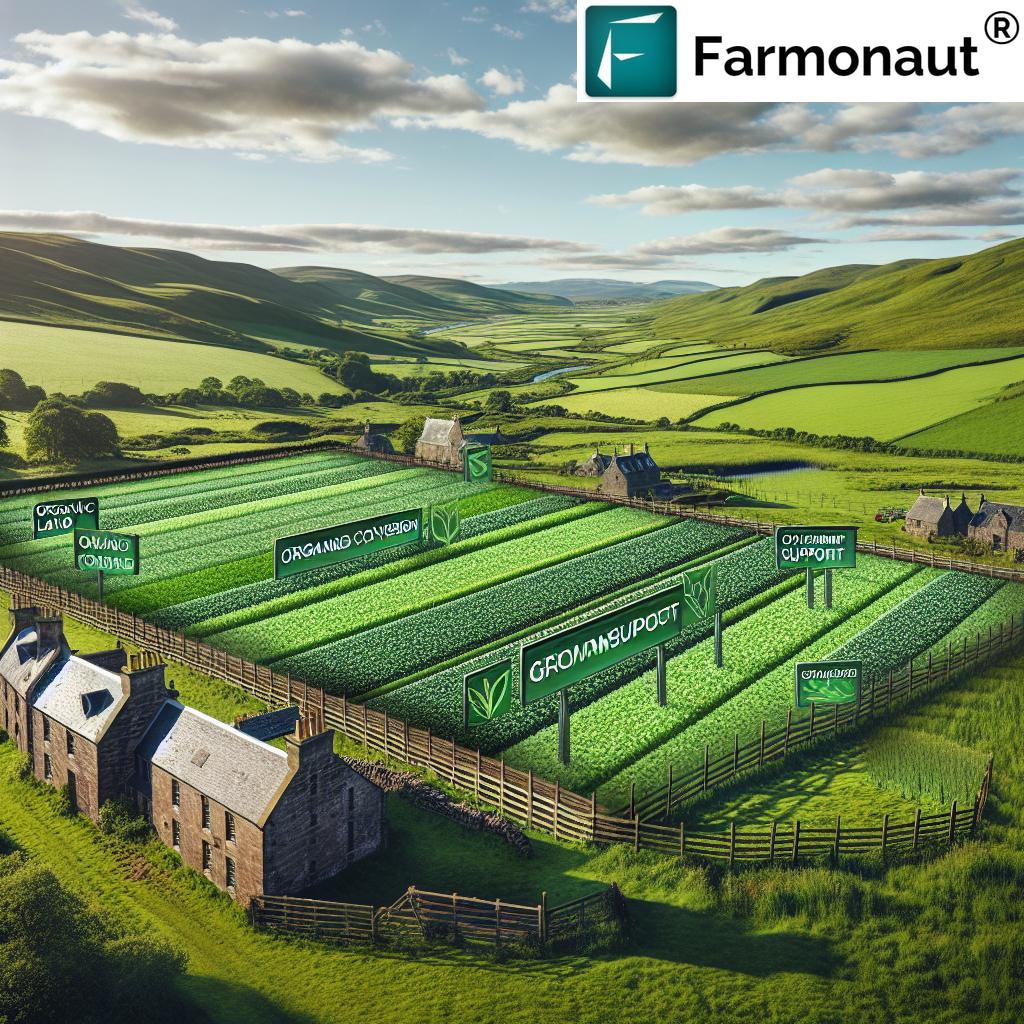Regenerative Agriculture UK: Boost Soil Health Fast!
“UK farms using regenerative practices can increase soil organic matter by up to 40% in just five years.”
Regenerative Agriculture in the UK: A Comprehensive Overview
Regenerative agriculture UK is transforming how we approach soil health improvement, biodiversity in agriculture, and sustainable farming practices. With mounting environmental pressures, soil degradation, and the need for resilient food production systems, both UK farmers and policymakers now recognise the potential of this innovative approach.
As we look to the future, regenerative agriculture is gaining momentum in the United Kingdom. This shift is not only about restoring soil and ecological balance, but also about creating economic viability for farmers, and ensuring that our food systems can adapt and thrive. In this blog, we will explore the key principles, adoption trends, sustainable practices, the essential role of technology with Farmonaut, financial and policy frameworks, and the primary benefits and challenges shaping the landscape of regenerative farming UK.
Core Principles of Regenerative Agriculture UK
At the heart of regenerative agriculture in the UK is a mission to go beyond mere sustainability, instead striving to regenerate soils and rebuild natural ecosystems. Our core aims include enriching soil organic matter, enhancing ecosystem resilience, and supporting thriving biodiversity. Let’s delve into the foundational principles that unite successful regenerative farming:
- Minimising Soil Disturbance: By reducing tillage or adopting no-till systems, we preserve soil structure, protect beneficial microorganisms, and limit carbon emissions. This approach directly combats erosion and supports soil health improvement.
- Maximising Biodiversity: Incorporating diverse crops, mixed plant species, and integrating livestock leads to a resilient ecosystem. More diversity means improved pest management, fertility, and resilience to weather extremes.
- Maintaining Soil Cover: Utilising cover crops and permanent ground mulches helps us prevent erosion, retain moisture, and feed soil microorganisms.
- Integrating Livestock: Employing rotational grazing and managed animal impact enhances nutrient cycling and increases soil organic matter (SOM), directly improving soil fertility.
- Enhancing Soil Organic Matter: Applying composts and organic amendments supports carbon sequestration and amplifies fertility and soil water retention.
Adoption and Momentum of Regenerative Practices in the UK
The United Kingdom is witnessing rising interest in regenerative agricultural practices. Several regional initiatives, pilot programmes, and national landscape projects signal growing support for transitioning away from extractive conventional agriculture. Below are some noteworthy 2024 developments:
- Cotswolds National Landscape Accelerator Programme: In April 2024, this accelerator invited 25 farmers and advisors to deepen their regenerative practices. This comprehensive programme includes workshops, on-farm events, and expert-led sessions (Details).
- High Weald National Landscape Guidance: Offering actionable guidance on minimising tillage, using cover crops UK, and integrating livestock to improve soil health and agricultural biodiversity (More info).
- First Milk’s Regenerative Programme: The largest dairy cooperative has implemented the largest regenerative farming programme in UK dairy, emphasizing sustainability and responsible food production (Know more).
- Unilever & Colman’s UK Project: 2024 saw a significant regenerative agriculture project from leading brands to ensure future food security, support soil regeneration, and combat degradation (Project details).
This fresh momentum is being matched by a growing array of learning events, online communities, and new technologies that make adopting regenerative practices more accessible than ever before.
Regenerative Agriculture UK: Key Sustainable Farming Practices
Let’s explore the fundamental techniques driving soil health improvement and increased biodiversity in UK agriculture. Each of the following methods supports ecosystem restoration and ensures sustainable production:
1. Reducing Tillage in Agriculture
- Minimising soil disturbance is central to regenerative agriculture UK. By reducing or eliminating tillage, we preserve soil structure, promote earthworm activity, and increase organic matter.
- This leads to better water infiltration, decreased erosion, and reduced input costs over time.
2. Utilising Cover Crops UK
- Planting cover crops between cash crop cycles provides continuous soil cover, preventing erosion and supporting microbial life.
- Legume cover crops sequester atmospheric nitrogen, further building soil fertility without synthetic inputs.
3. Rotational Grazing & Livestock Integration
- Managed livestock movements offer multiple regenerative farming benefits: increased biodiversity, better nutrient cycling, and enhanced soil fertility.
- This system mimics natural grazing patterns, which actively restores grassland ecosystems.
4. Organic Amendments & Crop Residue Recycling
- Using compost, mulch, and crop residues feeds soil microorganisms and increases soil carbon stocks.
- The result is improved soil structure, water holding capacity, and crop resilience during climate extremes.
5. Agroforestry & Biodiversity Corridors
- Introducing tree alleys, hedgerows, and buffer strips increases plant and animal species diversity on UK farms.
- These landscape elements support pollinators and create habitats for wildlife, boosting the ecological value of productive farmland.
“Regenerative agriculture boosts earthworm populations by 200% compared to conventional UK farming methods.”
Comparison Table of Regenerative vs. Conventional Agriculture Practices in the UK
| Practice | Description | Soil Health Impact (% Improvement) |
Biodiversity Benefit (% Increase) |
Carbon Sequestration (Tonnes/ha/year) |
Water Retention (% Improvement) |
|---|---|---|---|---|---|
| Cover Cropping (Regenerative) | Sowing legumes/grasses for continuous soil cover | 25–40% | 30–50% | 0.5–1.5 | 25–35% |
| Monocropping (Conventional) | Continuous single-crop planting | 0–5% | -5% | ~0 | 0–5% |
| Reduced/No-Till (Regenerative) | Minimal soil disturbance techniques | 20–30% | 20–30% | 0.3–1.2 | 15–20% |
| Conventional Ploughing | Deep, frequent cultivation | 0–3% | 0–3% | –0.3 to 0 | -5–5% |
| Integrated Livestock (Regenerative) | Rotational grazing integrated into crop cycles | 30–50% | 35–60% | 0.6–1.8 | 20–40% |
| Synthetic Fertiliser Use (Conventional) | Annual application of synthetic NPK | 3–8% | 0–5% | -0.1–0 | 3–10% |
Estimated values for illustration—actual improvements depend on farm location, soil type, and management intensity.
Innovative Technology & Farmonaut’s Role in Enhancing Regenerative Agriculture UK
Modern regenerative agriculture increasingly relies on technology for actionable insights and precision management. We believe Farmonaut offers an unparalleled set of tools to support UK farmers on this regenerative journey:
-
Satellite-Based Crop Health Monitoring:
Real-time satellite imagery enables detection of soil health issues, water stress, and crop disease before visible symptoms arise. This supports reducing inputs and targeted management—directly relevant for soil health improvement and minimising resource wastage. -
Jeevn AI Advisory System:
Offers personalised, AI-driven recommendations for regenerative practice adoption, responding to weather fluctuations and field conditions. -
Blockchain Traceability:
Secure, tamper-proof recordkeeping from farm to retail shelf enhances transparency, consumer trust, and food safety. (Learn about Farmonaut Traceability Solutions) -
Carbon Footprinting Tools:
Track on-farm carbon emissions and sequestration to demonstrate climate credentials and future-proof against new compliance standards. (Farmonaut Carbon Footprinting for UK Farms) -
Fleet & Resource Management:
Monitor machines, fuel use, and optimise logistics—lowering costs while reducing environmental impact. (Fleet Management Platform) -
API Integrations:
Developers and agribusinesses can access satellite and weather data with Farmonaut’s flexible API (API Access / Developer Docs).
For both large- and small-scale farms, the ability to access precise crop monitoring and field-specific data streamlines regenerative practice adoption—making the process affordable, scalable, and supported by scientific insights.
- Farmonaut’s crop loan and insurance verification tools help farmers gain easier access to financing, using satellite-verified field data. (See crop loan and insurance verification)
- For agribusinesses & policymakers, Farmonaut offers large scale farm management dashboards, supporting regional landscape monitoring and regenerative adoption tracking.
Financial Considerations: Costs, Yields, & Available Support
Adopting regenerative agriculture UK practices involves careful assessment of short-term financial impacts and long-term benefits. Let’s break down what UK farmers should expect:
Short-Term Financial Impacts
- The early years may see reduced yields or increased costs—as soil transitions, weed/pest profiles shift, or as new skills are acquired.
- Costs often include investing in cover crop seed, new rotational grazing setups, composting systems, or precision monitoring tools.
Long-Term Financial Benefits
- As soil health improves, farms experience higher yields, lower input costs (fertiliser, chemicals), and greater weather resilience.
- Better soil structure and SOM lead to reduced irrigation needs, stronger pest resistance, and healthier crops.
Support Mechanisms & Incentives
- The UK Sustainable Farming Incentive (SFI) offers payments for growing cover crops, reducing tillage, and other regenerative practices, providing a financial bridge while adoption matures.
-
Other local and national programmes support training, technical guidance, and peer learning.
Private financing options, like those streamlined by satellite-based verification with Farmonaut, reduce farmer risk in crop loans and insurance claims.
Challenges and Considerations for Regenerative Agriculture Adoption UK
As the adoption of regenerative practices takes hold, several challenges and factors must be addressed for long-term success in the UK:
- Education and Training:
Farmers often require hands-on training, field demonstrations, and access to local agricultural advisors experienced in regeneration. - Clear Policies and Incentives:
Policy frameworks and consistent financial incentives are needed to make the transition attractive and stable for farmers. - Market Demand:
Growth in consumer interest for “regeneratively produced” food can accelerate change by providing market premiums and secure supply contracts. - Data and Monitoring Tools:
Reliable, affordable soil health and biodiversity monitoring—such as Farmonaut’s satellite analytics—are essential for demonstrating progress and accessing results-based incentives. - Transition Risk Management:
Navigating short-term reduced yields or income variability during the first years of transition demands risk planning and resilience-building for UK farm businesses.
A coordinated effort across advisors, government, technology platforms like Farmonaut, and retail/consumer awareness will be key to overcoming these hurdles and scaling the benefits of regenerative farming UK.
FAQ: Regenerative Agriculture UK
What is the difference between regenerative and organic agriculture?
While both prioritise soil health improvement and ecosystem restoration, regenerative agriculture specifically focuses on restoring natural processes, increasing soil organic matter, and integrating animals and perennial plants—not just avoiding synthetic inputs. Organic standards can be regenerative but do not always encompass all key regenerative principles.
How quickly can UK farms see soil health improvement?
In favourable conditions, UK farms using cover crops, reduced tillage, and integrated livestock can increase soil organic matter by up to 40% in as little as five years, with visible benefits such as reduced erosion, increased worm activity, and improved yields.
What government programmes support adoption?
The Sustainable Farming Incentive (SFI) and local national landscape initiatives like Cotswolds Accelerator and High Weald guidance provide training, demonstration events, financial support, and technical resources for farmers.
Which crops work best within a regenerative system?
A diversity of crops—especially legumes, cover grasses, brassicas, and deep-rooted plants—combined with periodic livestock integration and agroforestry features, delivers optimal soil health and ecosystem resilience.
How does Farmonaut support regenerative agriculture?
Farmonaut’s platform offers real-time crop health monitoring, tailored AI advisory, blockchain-based traceability, carbon footprint tracking, fleet/resource management, and easy API integration—empowering UK farmers to adopt regenerative practices efficiently, reduce resource wastage, and confidently document their progress for consumers, buyers, and regulators.
Conclusion: Regenerative Agriculture UK for the Future
In summary, regenerative agriculture UK embodies an innovative approach to farming that seeks to repair the environment, secure food supplies, and revitalise rural communities. By harnessing the power of nature, modern science, and data-driven solutions like those from Farmonaut, we can boost soil health fast, foster biodiversity, and future-proof our farms against climate and market risks.
Through supportive policies, smart financial incentives, hands-on training, and widespread consumer education, the United Kingdom is poised to become a global leader in sustainable, regenerative agricultural production. The journey starts with science-backed decision-making, roots itself in healthy soils, and culminates in thriving, resilient communities.
Ready to monitor your fields, track carbon, and embrace the next era of farming? See for yourself with Farmonaut’s advanced tools for regenerative agriculture:
- Monitor and reduce your farm’s carbon footprint for higher sustainability and regulatory compliance with Farmonaut’s carbon tracking.
- Enhance transparency and traceability for both food buyers and consumers.
- Simplify crop loan & insurance processes using satellite verification.
Farmonaut Subscription Plans
Farmonaut’s subscription model offers flexibility, advanced analytics, and affordability—making precision agriculture accessible for UK farmers, agribusinesses, and institutions of all sizes.


















